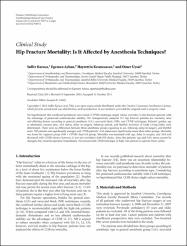| dc.contributor.author | Karaca, Saffet | |
| dc.contributor.author | Ayhan, Egemen | |
| dc.contributor.author | Kesmezacar, Hayrettin | |
| dc.contributor.author | Uysal, Ömer | |
| dc.date.accessioned | 2016-08-24T11:21:17Z | |
| dc.date.available | 2016-08-24T11:21:17Z | |
| dc.date.issued | 2012 | |
| dc.identifier.citation | Karaca S, Ayhan E, Kesmezacar H, Uysal O. Hip fracture mortality: Is it affected by anesthesia techniques? Anesthesiology Research and Practice. 2012. doi: 10.1155/2012/708754 | en_US |
| dc.identifier.issn | 1687-6962 | |
| dc.identifier.uri | http://www.hindawi.com/journals/arp/2012/708754/ | en_US |
| dc.identifier.uri | https://hdl.handle.net/11446/1077 | en_US |
| dc.description | İstanbul Bilim Üniversitesi, Tıp Fakültesi. | en_US |
| dc.description.abstract | We hypothesized that combined peripheral nerve block (CPNB) technique might reduce mortality in hip fracture patients with the advantage of preserved cardiovascular stability. We retrospectively analyzed 257 hip fracture patients for mortality rates and affecting factors according to general anesthesia (GA), neuraxial block (NB), and CPNB techniques. Patients’ gender, age at admission, trauma date, ASA status, delay in surgery, followup period, and Barthel Activities of Daily Living Index were determined. There were no differences between three anesthesia groups regarding to sex, followup, delay in surgery, and Barthel score. NB patients was significantly younger and CPNB patients’ ASA status were significantly worse than other groups. Mortality was lower for regional group (NB + CPNB) than GA group. Mortality was increased with age, delay in surgery, and ASA and decreased with CPNB choice; however, it was not correlated with NB choice. Since the patients’ age and ASA status cannot be changed, they must be operated immediately. We recommend CPNB technique in high-risk patients to operate them earlier. | en_US |
| dc.language.iso | eng | en_US |
| dc.publisher | Hindawi Publishing Corporation | en_US |
| dc.identifier.doi | 10.1155/2012/708754 | en_US |
| dc.rights | info:eu-repo/semantics/openAccess | en_US |
| dc.title | Hip fracture mortality: Is it affected by anesthesia techniques? | en_US |
| dc.type | article | en_US |
| dc.relation.journal | Anesthesiology Research and Practice | en_US |
| dc.department | DBÜ, Tıp Fakültesi | en_US |
| dc.contributor.authorID | TR4713 | en_US |
| dc.contributor.authorID | TR120412 | en_US |
| dc.contributor.authorID | TR146447 | en_US |
| dc.contributor.authorID | TR50053 | en_US |
| dc.relation.publicationcategory | Belirsiz | en_US |


















